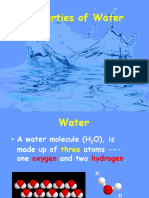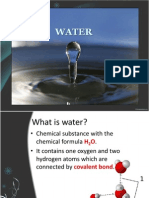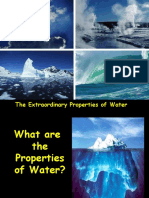Repel Water Molecules Attracted To Each Other: Specific Heat Capacity
Uploaded by
api-296833859Repel Water Molecules Attracted To Each Other: Specific Heat Capacity
Uploaded by
api-296833859Two reasons why water is important:
1. It makes up about 70 - 95% of cell mass. Humans are about 60% water.
2. 3/4 of the planet is covered in water and it is the environment for many organisms.
Water has certain special properties:
- Water acts as a solvent:
This is because of its attraction to ions and polar molecules. This attraction separates
these particles and causes them to dissolve in water.
Non-polar molecules are pushed together due to the fact that they repel water molecules
and are attracted to each other.
- Water has a high specific heat capacity:
Specific heat capacity: The amount of heat needed to raise a substances temperature by
a given amount. For water it is the heat energy required to raise the temperature of 1 kg
of water by 1 .
Because of the hydrogen bonds in water, it is harder for water molecules to move about.
For an increase in temperature, molecules must gain energy (kinetic) and move about
more rapidly. Thus, hydrogen bonds allow water to store more energy than would
otherwise be possible for a given temperature.
- Water has a high latent heat of vapourisation:
Latent heat of vapourisation: A measure of the amount of heat needed to vapourise a
liquid.
Because of its high specific heat capacity water has a high latent heat of vapourisation.
For water to vapourise relatively large amounts of energy must be used to break the
hydrogen bonds between the molecules.
The energy transferred to a water molecule during vapourisation results in a
corresponding loss of energy from its surroundings. So, a large amount of energy can be
lost for relatively little amounts of water loss.
The water molecules must also lose a relatively large amount of energy to freeze.
- Below 4 , the density of water begins to decrease (due to hydrogen bonding).
- Water molecules have high cohesion (they stick together). This results in high surface
tension.
- Water sometimes acts as a reagent:
In plants, energy from sunlight is used to separate the hydrogen and oxygen in water. The
hydrogen provides energy for plants (e.g. making glucose). The waste oxygen goes into
the atmosphere and is used for aerobic respiration.
In hydrolysis, water molecules are used in reactions which break down larger molecules
into smaller ones.
You might also like
- Molecules of Life: 1.1 A) Explain The Structure of Water MoleculeNo ratings yetMolecules of Life: 1.1 A) Explain The Structure of Water Molecule37 pages
- Lesson 3 Properties of Water Molecular Structure and IMFNo ratings yetLesson 3 Properties of Water Molecular Structure and IMF37 pages
- Structure and Properties of Water: Read Pages 1 - 7 in Biology Unit 1 For CAPE ExaminationsNo ratings yetStructure and Properties of Water: Read Pages 1 - 7 in Biology Unit 1 For CAPE Examinations21 pages
- Physical Properties of Water: Melting and Boiling Points Specific HeatNo ratings yetPhysical Properties of Water: Melting and Boiling Points Specific Heat10 pages
- Physical and chemical properties of waterNo ratings yetPhysical and chemical properties of water16 pages
- Section 2.2.2-NOTES Properties of Water 2019No ratings yetSection 2.2.2-NOTES Properties of Water 201928 pages
- Lesson4 Peculiar-Water Updated-Version Copy01of1No ratings yetLesson4 Peculiar-Water Updated-Version Copy01of137 pages
- Biochem Lesson 4 Water-and-Its-PropertiesNo ratings yetBiochem Lesson 4 Water-and-Its-Properties28 pages
- Properties of Water - Its Chemistry and Some PhysicsNo ratings yetProperties of Water - Its Chemistry and Some Physics44 pages
- Introduction To Bioengineering (BBL1020)No ratings yetIntroduction To Bioengineering (BBL1020)25 pages
- Water Revision Notes a-Level Biology CIE CognitoNo ratings yetWater Revision Notes a-Level Biology CIE Cognito1 page
- Molecules of Life: 1.1 WATER 1.2 Carbohydrates 1.3 Lipids 1.4 Proteins 1.5 Dna & RnaNo ratings yetMolecules of Life: 1.1 WATER 1.2 Carbohydrates 1.3 Lipids 1.4 Proteins 1.5 Dna & Rna30 pages
- Molecules of Life: 1.1 WATER 1.2 Carbohydrates 1.3 Lipids 1.4 Proteins 1.5 Nucleic AcidsNo ratings yetMolecules of Life: 1.1 WATER 1.2 Carbohydrates 1.3 Lipids 1.4 Proteins 1.5 Nucleic Acids35 pages
- Inbreeding Interbreeding Outbreeding Inbreeding DepressionNo ratings yetInbreeding Interbreeding Outbreeding Inbreeding Depression1 page
- Negative Effects of Growing Herbicide Resistant Crops IncludeNo ratings yetNegative Effects of Growing Herbicide Resistant Crops Include3 pages
- Selective Advantage Natural Selection Selection Pressure: Speciation SpeciesNo ratings yetSelective Advantage Natural Selection Selection Pressure: Speciation Species2 pages
- Coevolution Fitness Natural Selection: Discontinuous VariationNo ratings yetCoevolution Fitness Natural Selection: Discontinuous Variation2 pages
- Overcrowded Substandard Housing Low ImmunityNo ratings yetOvercrowded Substandard Housing Low Immunity2 pages
- Organic Molecule Respiration Potential Energy Chemical Potential EnergyNo ratings yetOrganic Molecule Respiration Potential Energy Chemical Potential Energy1 page
- High Energy Bonds: Universal Intermediary MoleculeNo ratings yetHigh Energy Bonds: Universal Intermediary Molecule2 pages
- Anaerobic Respiration (In The: CytoplasmNo ratings yetAnaerobic Respiration (In The: Cytoplasm1 page
- Gas Exchange: One (1.8 CM) Yes Yes Yes Yes No YesNo ratings yetGas Exchange: One (1.8 CM) Yes Yes Yes Yes No Yes2 pages























































































